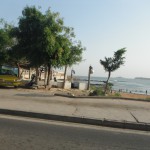On the Atlantic Ocean, the city of Dakar, capital of Senegal, lies thick across the Cap Vert Peninsula, western most point of Africa, and spreads east as the peninsula widens and the city fades into dry savanna. Three million people who speak a half dozen languages live here, once the nerve center of the vast unbroken territory from the sea to Lake Chad the French called their own under the name l’Afrique Occidentale Francaise. This city of whitewashed buildings, great churches and mosques, part Paris and part Casablanca, mix of urban chic and fishing village, celebrates its relationship with France. The presidential palace, former residence of the governor general, dominates the city center on the Avenue Leopold Sedar Senghor—the poet and intellectual who defied his love affair with France to break away and lead his country to independence. The guard at the front gate wears brilliant colonial dress: red tunic, boots, fluffy dark pants and a floppy blue chefia fez. From here, the streets fan out in narrow byways choked with traffic and street vendors who sell Muslim prayer rugs, shoes, soap, spices, sugar, second hand clothing, auto parts, and cell phones in front of chic patisseries and clothing shops. Dakar offers little hint of the hot and dry savanna inland. And that is where I am headed, east into Senegal and beyond, a land Dakar could care less about, as if the city is furiously trying to deny Africa’s rural realities. Dakar’s newspapers ignore the provinces, except for stories about crime and auto accidents. The train that connects Dakar across the country to Bamako, capital of neighboring Mali, stopped running years ago, leaving the population a limited national highway system choked with trucks and fearful travelers in aging buses and cars.
“Outside the cities,” Boubacar Barry, a historian at the University of Dakar warned me, “people live with little sense of government or of the nation state state and its borders. They like it that way.”

